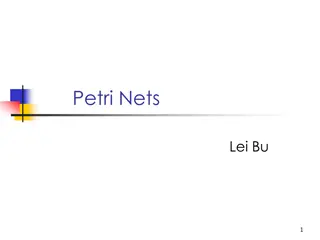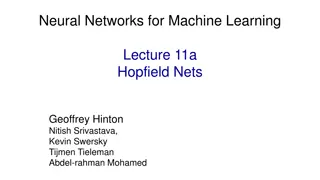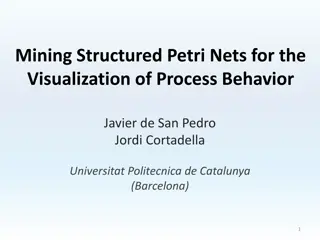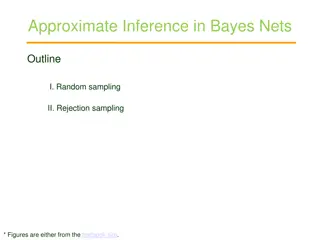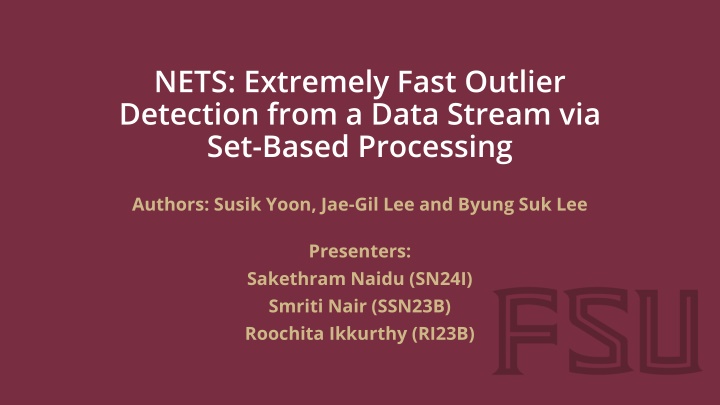
Fast Outlier Detection using Set-Based Processing in Data Streams
Discover how NETS revolutionizes outlier detection in real-time data streams using set-based processing, reducing computational costs and enhancing anomaly detection efficiency. Explore the grid-based approach, cell-level, and point-level detection techniques for faster and smarter outlier identification.
Uploaded on | 0 Views
Download Presentation

Please find below an Image/Link to download the presentation.
The content on the website is provided AS IS for your information and personal use only. It may not be sold, licensed, or shared on other websites without obtaining consent from the author. If you encounter any issues during the download, it is possible that the publisher has removed the file from their server.
You are allowed to download the files provided on this website for personal or commercial use, subject to the condition that they are used lawfully. All files are the property of their respective owners.
The content on the website is provided AS IS for your information and personal use only. It may not be sold, licensed, or shared on other websites without obtaining consent from the author.
E N D
Presentation Transcript
NETS: Extremely Fast Outlier Detection from a Data Stream via Set-Based Processing Authors: Susik Yoon, Jae-Gil Lee and Byung Suk Lee Presenters: Sakethram Naidu (SN24I) Smriti Nair (SSN23B) Roochita Ikkurthy (RI23B)
Problem & Motivation Outlier detection in real-time data streams is crucial in domains like healthcare, finance, and security. Most existing methods use sliding windows, where each window shift introduces expired and new data. These methods treat expired and incoming points independently, failing to exploit spatial locality. This results in high computational cost, redundant updates, and delayed detection of anomalies. A more efficient method would process both slides together, minimizing recomputation.
Why Current Methods Struggle State-of-the-art methods like MCOD and LEAP rely on point-based processing. They handle each data point separately and process expired and new data independently. This ignores proximity between points across slides, leading to unnecessary neighbor checks. These repeated calculations lead to inefficiencies, especially in high-velocity data streams. NETS introduces set-based updates and computes a net effect across slides to reduce overhead.
NETS - NET effect-based Stream outlier detection NETS introduces set-based processing by grouping similar data points in grid cells. Computes the net effect of expired vs. new data points in each region. Avoids redundant computation caused by similar data in consecutive windows. Leverages both intra-slide proximity and inter-slide proximity. Leads to faster and smarter detection of true outliers
Grid Index & Cardinality Grid The data space is partitioned into a grid of equal-sized cells (hypercubes). Each cell represents a region of the space and acts as a set. A cardinality grid maintains the number of points inside each cell. Fast lookup: A point s cell is computed via coordinate division. Enables efficient net-effect calculation and set-level neighbor detection.
Cell-level and Point-level detection Cell-Level Detection: Compute neighbor lower (L) and upper (U) bounds. If L(c) K all inliers. If U(c) < K all outliers. Point-Level Detection: For non-determined cells, inspect individual points. Use the prior window s neighbour information. Avoids full re-computation for most points. L(c) = card(c) 1 U(c) = c N(c) card(c ) + card(c) - 1
Experimental Results Tested on 6 real-world and 1 synthetic dataset: Real-world datasets: STK, TAO, HPC, GAS, EM, FC. Synthetic dataset: GAU (Generated by a Gaussian Mixture Model with three distributions) Algorithms Used: MCOD , LEAP , exact-Storm , Abstract-C and DUE Comparison Metrics: CPU Time, Peak Memory Usage, Scalability, Robustness. Parameters: W, S, R, K.
CPU Time: NETS consistently exhibits the lowest CPU time across all datasets, indicating a high-speed improvement over other algorithms. The time difference is especially noticeable in datasets like GAU and TAO, where NETS achieves a significantly lower CPU time. Memory Usage: NETS maintains consistently lower or comparable memory usage compared to other algorithms. Despite having the fastest processing speed, NETS does not compromise on memory efficiency, making it suitable for real-time applications.
Metric NETS (Proposed) MCOD LEAP exact- Storm Abstract- C DUE 1x 0.42x 0.0002x 0.0002x 0.00 03x Speed Improvement 10x Moderate High Very High High High Peak Memory Usage Low Good Poor Very Poor Poor Poor Scalability Excellent Moderate Poor Poor Poor Poor Robustness (Parameter Variations) Excellent Inconsistent Poor Very Poor Poor Poor Consistent Efficiency with W Significant Impact Poor Very Poor Poor Poor Minimal Impact Efficiency with S Moderate Poor Very Poor Poor Poor High Efficiency Efficiency with R Poor Very Poor Very Poor Poor Poor Excellent Efficiency with K
Conclusion 1. Superior Performance: NETS consistently outperforms existing algorithms (MCOD, LEAP, exact-Storm, Abstract-C, DUE) across all major performance metrics. Scalability: Demonstrates excellent scalability across various datasets (GAU, STK, TAO, HPC, GAS, EM, FC), maintaining low processing time regardless of dataset size or complexity. Memory Efficiency: Achieves remarkable efficiency in memory usage, performing better or comparable to other algorithms while processing data streams quickly. Robustness: The algorithm remains robust under varying conditions of parameters ( W, S, R, K), showing consistency across all scenarios. Versatility and Practicality: NETS is particularly suited for real-time applications due to its low memory usage and high processing speed. 2. 3. 4. 5.


